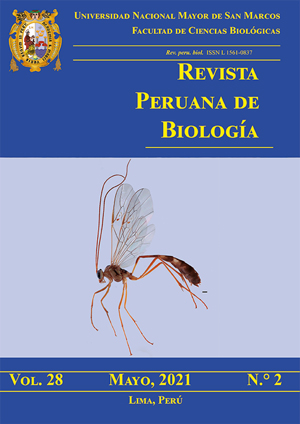Current status of Cheracebus sp. (Primates: Pitheciidae) and of its habitat between the Tigre and Nanay rivers, Peruvian Amazon
DOI:
https://doi.org/10.15381/rpb.v28i2.20463Keywords:
Primate conservations, hunting pressure, group size, titi monkey abundance, habitat disturbanceAbstract
With the exception of the forests of the Itaya river basin, the area of influence of the Iquitos-Nauta highway and the middle basin of the Nanay and Tigre rivers, there is no information on the current status of Cheracebus sp. populations and habitat, which motivated this study. The objectives were aimed at obtaining more information on Cheracebus sp. and the state of its populations. Linear transect censuses were conducted from May to November 2019 in forests of the Itaya, Nanay and Tigre river basins. In 1659 km of covered length, 32 groups were sighted; of them, 17 corresponded to the Nanay river basin. Groups with four individuals were seen more frequently in the Nanay river basin; relative abundance and population density were slightly higher in the Itaya river basin with 0.3 groups/ 10 km and 4.2 individuals/ km2. In the study area, forests are highly disturbed from the banks of rivers and streams up to approximately 0.7 km inland. The low population density of Cheracebus sp. is a consequence of high hunting pressure, particularly in the Tigre river basin; added to this is the high disturbance of the forests due to the extraction of timber trees and other resources; which would be causing a shortage of food resources for this and other primates.
Downloads
Downloads
Published
Issue
Section
License
Copyright (c) 2021 Rolando Aquino, Iris Arévalo, Etersit Pezo, Luis López

This work is licensed under a Creative Commons Attribution 4.0 International License.
AUTHORS RETAIN THEIR RIGHTS:
a. Authors retain their trade mark rights and patent, and also on any process or procedure described in the article.
b. Authors retain their right to share, copy, distribute, perform and publicly communicate their article (eg, to place their article in an institutional repository or publish it in a book), with an acknowledgment of its initial publication in the Revista Peruana de Biologia.
c. Authors retain theirs right to make a subsequent publication of their work, to use the article or any part thereof (eg a compilation of his papers, lecture notes, thesis, or a book), always indicating its initial publication in the Revista Peruana de Biologia (the originator of the work, journal, volume, number and date).






